

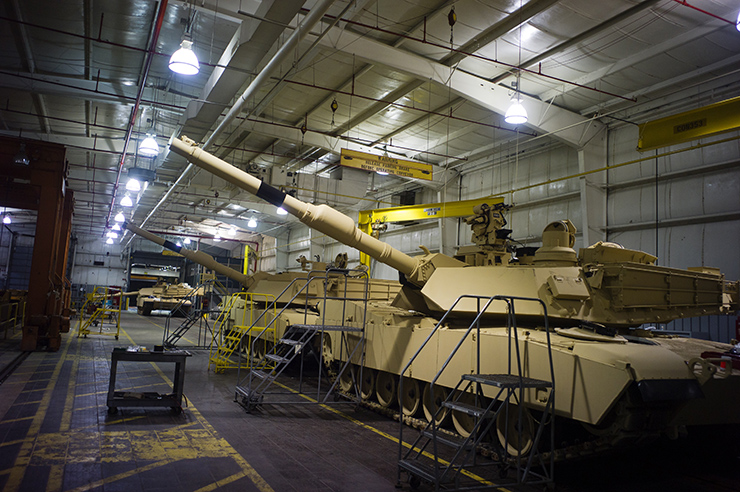
The Army began the XM815 project in January 1972. The Main Battle Tank Task Force was established under Major General William Desobry. The task force prepared design studies with the technical support of Tank-automotive and Armaments Command (TACOM).
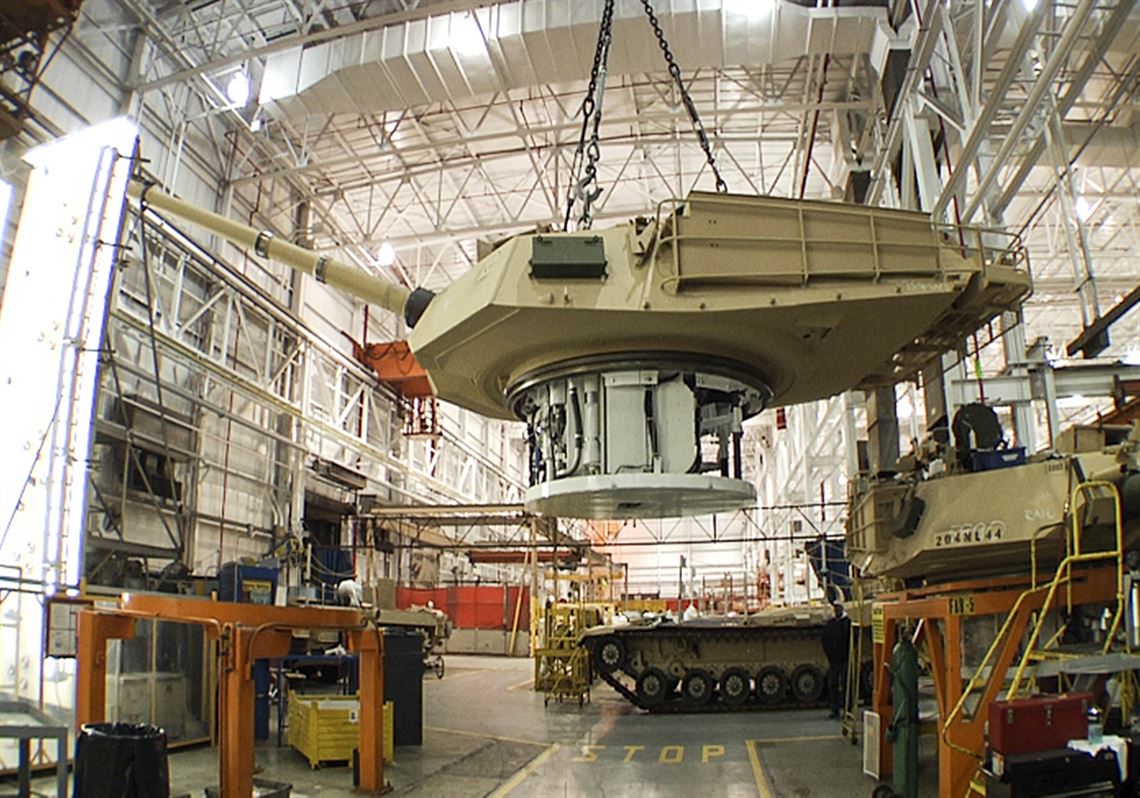
In spring 1962, Desobry was briefed by the British on their own newly developed "Burlington" armor from the British Army's labs. The armor performed exceptionally against shaped charges such as HEAT rounds. In September, Desobry convinced the Army to incorporate the new armor. In order to take full advantage of Burlington, also known as Chobham, the new tank would have to have armor around two feet thick (for comparison, the armor on the M60 is around four inches thick). General Creighton Abrams set the weight of the new tank at 58 short tons (53 t). The original goal of keeping weight under 50 short tons (45 t) was abandoned.
The XM1 program was approved to begin in January 1973. TACOM began examining specific goals. After several rounds of input, the decision was made to provide armor to defeat the "heavy threat" posed by the T-62's 115 mm gun using projected improvements of their armor-piercing fin-stabilized discarding sabot (APFSDS) ammunition through the 1980s, and the new 125 mm gun of the T-64 and T-72 firing HEAT rounds. To this end, a new design basis emerged in February 1973. It had to defeat any hit from a Soviet gun within 800 m (2,600 ft) and 30 degrees to either side. The tank would be armed with the 105 mm M68 gun, a licensed version of the Royal Ordnance L7, and a 20 mm version of the M242 Bushmaster. The Army later deleted the latter from the design, seeing it as superfluous.
In May 1973, Chrysler Defense and General Motors submitted proposals. Both were armed with the 105 mm M68 gun, the licensed L7, and the 20 mm Bushmaster. Chrysler chose a 1,500 hp gas turbine Lycoming AGT1500. GM's model was powered by a 1,500 hp diesel similar to that used on the American MBT-70 and XM803.
At the time, the Pentagon's procurement system was beset with problems being caused by the desire to have the best possible design. This often resulted in programs being canceled due to cost overruns, leaving the forces with outdated systems, as was the case with the MBT-70. There was a strong movement within the Army to get a new design within budget to prevent the MBT-70 experience from repeating itself. For the new design, the Army stated the unit cost was to be no more than $507,000 in 1972 dollars (equivalent to $3,550,000 in 2022).
The Pentagon's approach to control of research and development was modified with the XM1. Previous acquisition strategy called for a significant amount of the design work be done by the government. Under the new framework, contractors would competitively bid their own designs rather than compete solely for the right to manufacture the end product.
Through the period while the initial prototypes were being built, a debate broke out between Germany and US about the use of the 105 mm gun. The Army was planning on introducing several new types of ammunition for the 105 that would greatly improve its performance, notably, the XM-774 using depleted uranium. These rounds would give it the performance needed to defeat any Soviet tank with ease. There was some concern that depleted uranium would not be allowed in Germany, perhaps just in peacetime, so improvements to the tungsten cored M735 were also considered.
Through this same period, there was an ongoing effort to improve NATO logistics by standardizing ammunition to the maximum possible degree. The Germans were moving ahead with their 120 mm gun on the Leopard 2K, and noted that the British had also introduced a 120 mm gun of their own in keeping with their long-range combat doctrine.
By 1977 the decision had been made to eventually move the new tank to a 120 mm gun. After head-to-head testing between the Royal Ordnance L11A5 and the Rh-120, the latter was chosen and later type-classified as the M256. The turret designs of the two prototypes were modified to allow either gun to be fitted. Although the L11/M256 120mm gun was chosen to be the main weapon of the Abrams in 1979, the improved ammunition for the gun still was not fully developed, thus delaying its fielding until 1984.
The early production versions of the M1 Abrams (M1 & IPM1) were armed with the M68A1 for two reasons. First was due to the large number of M60 tanks with the M68E1 gun still in widespread US service in the 1980s and a large on-hand stockpile of 105 mm munitions. Fitting the M1 with the M68A1 gun was viewed as an economical and practical solution that allowed for commonality in ammunition among the two types of tanks. Secondly was that the M68A1 could employ the newly developed M900 APFSDS[citation needed] depleted uranium round that had improved penetration performance in comparison to the M774.
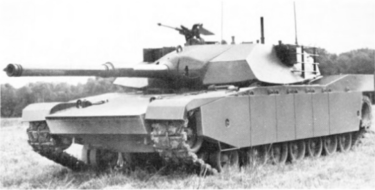
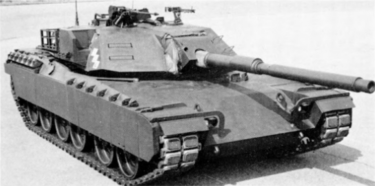
Prototypes were delivered in 1976 by Chrysler and GM armed with the M68E1 105 mm gun. They entered head-to-head testing at Aberdeen Proving Ground, along with a Leopard 2 AV prototype for comparison. The Leopard 2 was found to meet U.S. requirements but was thought to cost more. The testing showed that the GM design was generally superior to Chrysler's, offering better armor protection, and better fire control and turret stabilization systems. These early preproduction prototypes were provisionally armed with the M68E1 105mm main gun while a preferred 120 mm gun and its ammunition were in their design and component development phase. These prototypes used a combination mount that allowed for evaluating both 105 and 120 mm guns.
During testing, the power packs of both designs proved to have issues. The Chrysler gas turbine engine had extensive heat recovery systems in an attempt to improve its fuel efficiency to something similar to a traditional internal combustion engine. This proved not to be the case: the engine consumed much more fuel than expected, burning 3.8 US gallons per mile (890 L/100 km). The GM design used a new variable-compression diesel design.
By spring 1976, the decision to choose the GM design was largely complete. In addition to offering better overall performance, there were concerns about Chrysler's engine both from a reliability and fuel consumption standpoint. The GM program was also slightly cheaper overall at $208 million compared to $221 million for Chrysler. In July 1976, the Army prepared to inform Congress of the decision to move ahead with the GM design. All that was required was the final sign-off by the Secretary of Defense, Donald Rumsfeld.
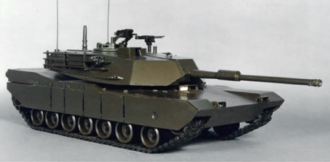
On 20 July 1976, United States Secretary of the Army Martin Hoffmann and a group of generals visited Deputy Defense Secretary Bill Clements and Director of Defense Research and Engineering Malcolm Currie on their decision. They were surprised when Clements and Currie criticized their decision and demanded the turbine be selected. Donald Rumsfeld heard arguments from both in the afternoon. The Army team spent the night writing briefs and presented them to Rumsfeld the next morning, who then announced a four-month delay.
Within days, GM was asked to present a new design with a turbine engine. According to Assistant Secretary for Research and Development Ed Miller, "It became increasingly clear that the only solution which would be acceptable to Clements and Currie was the turbine... It was a political decision that was reached, and for all intents and purposes that decision gave the award to Chrysler since they were the only contractor with a gas turbine."
On 12 November 1976, the Defense Department awarded a $20 billion development contract to Chrysler.
The turbine engine does not appear to be the only reason for this decision. Chrysler was the only company that appeared to be seriously interested in tank development; the M60 had been lucrative for the company and relied on that program for much of its profit. In contrast, GM made only about 1% of its income from military sales, compared to 5% for Chrysler, and only submitted their bid after a "special plea" from the Pentagon.
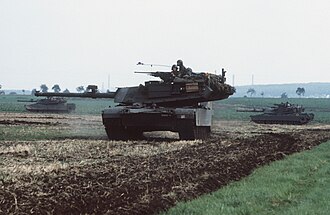
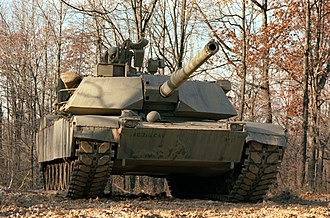
In January 1978, a program was initiated to develop an enhanced version of the 105mm gun, the M68A1 as a possible alternate weapon for the M1 Abrams. The new XM24/L55 gun barrel was 18 inches (45.72 cm) longer in comparison to the XM24/L52 barrel used on the M60 tanks. It has a higher chamber pressure, reinforced breech and a higher muzzle velocity
Low rate initial production (LRIP) of the vehicle was approved on 7 May 1979. In February 1982, General Dynamics Land Systems Division (GDLS) purchased Chrysler Defense, after Chrysler built over 1,000 M1s.
A total of 3,273 M1 Abrams tanks were produced during 1979 1985 and first entered U.S. Army service in 1980. Production at the government-owned, GDLS-operated Lima Army Tank Plant in Lima, Ohio, was joined by vehicles built at the Detroit Arsenal Tank Plant in Warren, Michigan from 1982 to 1996. The U.S. Army Laboratory Command (LABCOM), under the supervision of the United States Army Research Laboratory (ARL), was also heavily involved with designing the tank with M1A1 armor resistant shells, M829A2 armor-penetrating rounds, and improved weapon range.
The M1 was armed with the license-built M68A1 version of the 105 mm Royal Ordnance L7 gun. The tank featured the first of its kind Chobham armor. The M1 Abrams was the first to use this advanced armor. It consisted of an arrangement of metal plates, ceramic blocks and open space. An improved model called the M1IP was produced briefly in 1984 and contained upgrades to armour and other small improvements. The M1IP models were used in the Canadian Army Trophy NATO tank gunnery competition in 1985 and 1987.
About 5,000 M1A1 Abrams tanks were produced from 1986 to 1992 and featured the M256 120 mm (4.7 in) smoothbore cannon developed by Rheinmetall AG of Germany for the Leopard 2, improved armor, consisting of depleted uranium and other classified materials, and a CBRN protection system. Production of M1 and M1A1 tanks totaled some 9,000 tanks at a cost of approximately $4.3 million per unit.
In 1990, Project On Government Oversight in a report criticized the M1's high costs and low fuel efficiency in comparison with other tanks of similar power and effectiveness such as the Leopard 2.
As the Abrams entered service, they operated alongside M60A3 within the U.S. military, and with other NATO tanks in various Cold War exercises which usually took place in Western Europe, especially West Germany. The exercises were aimed at countering Soviet forces.
Adaptations before the Gulf War (Operations Desert Shield and Desert Storm) gave the vehicle better firepower and NBC (Nuclear, Biological and Chemical) protection.